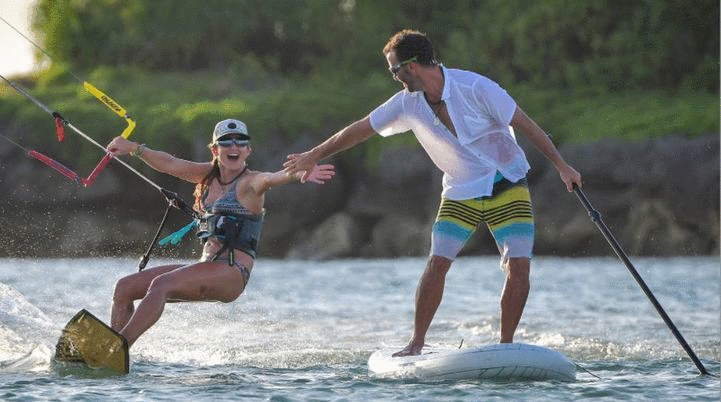Master The Foiling Jibe In 3 Easy Steps
- Romain
- Apr 8, 2020
- 4 min read
Jibing is a basic transition in windsurf, and of course a move any windfoiler will want to acquire as soon as possible. Here is hopefully all the explanations to help you master the windfoil jibe and impress your mates on the beach.

Windfoiling is like starting windsurfing from scratch.
Windfoiling is like being a windsurf beginner again. Basically, you’ll need to learn everything from scratch, and it’s probably the reason why it is so fun. It gives new challenges to those who have been windsurfing for a long time but experiencing a flat learning curve the past years.
When you begin on a foil, you will get the same sensations as when you started funboarding years ago: finding the right position of your feet, of your body, and of course dicovering the new fantastic flying sensations.
IF YOU WANT TO LEARN HOW TO WINDFOIL, YOU CAN ALSO CHECK OUT
You will even experience awesome catapults in your rig, as in the former days!
At start, you will most probably need to focus on controlling the height on the foil, and master foiling back and forth. After a while, you will seek new challenges, and jibing in the air is of course a move you will want to master.
Here is a perfect foiling jibe by Antoine Questel:
Learn to foil-jibe in three steps.
Learning the jibe in the air is probably not going to happen at your first attempt, but this is the goal to have in mind. In a recent interview for the German windsurf magazine “Surf Magazin”, Sebastian Kornum (DEN) gave some tips to learn the foiling jibe.
His approach is interesting as his advice is to practice the foiling jibe in three steps, instead of going straight to the “air jibe”, with your board fully out of the water during the whole turn.
Here are the 3 steps:
1- Sliding jibe
This is a basic sliding jibe on the water: You go down on the water before entering the jibe, and turn with the board sliding on the water, as you would do with a regular windsurf board.
The only difference is your body weight, which should be a little bit more back on the board compared to a regular windsurf board. You will indeed need more pressure on the foil to make the board turn compared to a regular fin.

(film credit: surf magazin / Sebastian Kornum)
2- The semi-foiling jibe
When getting more confident, try the second step which is the semi-foiling jibe: You enter the curve above the water on your foil, and start to carve with your feet, still outside the water.
The tricky part of the foiling jibe is the rotation of the sail and switching the position of the feet. The purpose of the semi-foiling jibe is to make the end of maneuver easier by going down on the water at the end of the jibe.
You can then rotate the sail and switch your feet easily as in a regular windsurf jibe.

3- The fully-foiling jibe
Ready for the last step? This is for the experts, something you will need to practice before you finally nail it.
The goal is of course to foil all the way around the turn. This way you will build an incredible amount of speed out of the turn, ready for another run. Best of all: this high-speed turn works even in light wind conditions.
Mastering the foil-jibe will give you completely new sensations, which are difficult to describe with words. This should make you addicted to foil.

Step by step instructions to jibe like a pro
Here are some more detailed explanations on how to proceed to complete the foiling jibe:
1- Approach:
You are sailing straight on your foil, the weight of the body on the front leg. Unhook your harness lines.
2- Back foot placement:
Just before entering the jibe, slow down a little bit, remove gently your back foot out of the footstrap and place it on the opposite rail of the board, without pressing too hard.
3- Carving:
Now you simply have to lean slightly into the turn and you will be carving. Steer the turn with your back foot, keeping a constant pressure through the whole turn. The foil will naturally want to come back in the opposite direction, so do not release the pressure at any moment. If you do not manage to turn completely, increase the pressure on the back foot.
4- Sail position:
Sebastian Kornum recommends opening up your backhand when you start carving and start to rotate the sail early. I personally prefer to keep some power in the sail for better balance, but this is practice and learning which will make you find the right technique and style. If you keep the sail powered up, be careful not to close the sail too much, as you may get backwinded due to apparent wind coming to you.
5- Board pitch:
When you are completely downwind, replace your body well above the board to control balance on the foil. Try to keep the pitch of the board as flat as possible during the turn. If the nose of the board is pointing up, the foil will rise and may come too close to the surface, which will stop the movement.
6- Sail rotation:
Rotate the sail relatively early in the turn, when you feel that there is no more traction. The rotation needs to be quick if you want to maintain balance on your board, because the high speed in the turn makes the sail heavy and difficult to rotate. After some training, you should be able to rotate the sail without any effort, so you can concentrate on the position of your feet to make the perfect turn.
7- Switch feet:
And the end of the rotation, switch your feet. Be light on your feet! Ideally, the new front foot should land in or near the front strap.
8- Final step:
Hook you harness line, place your back foot in the strap and ready to go!
Some more inspiration before making a try on the water? Check this video of Benjamin Tiller making his "real air jibe" as he calls it:
Good luck!








Comments